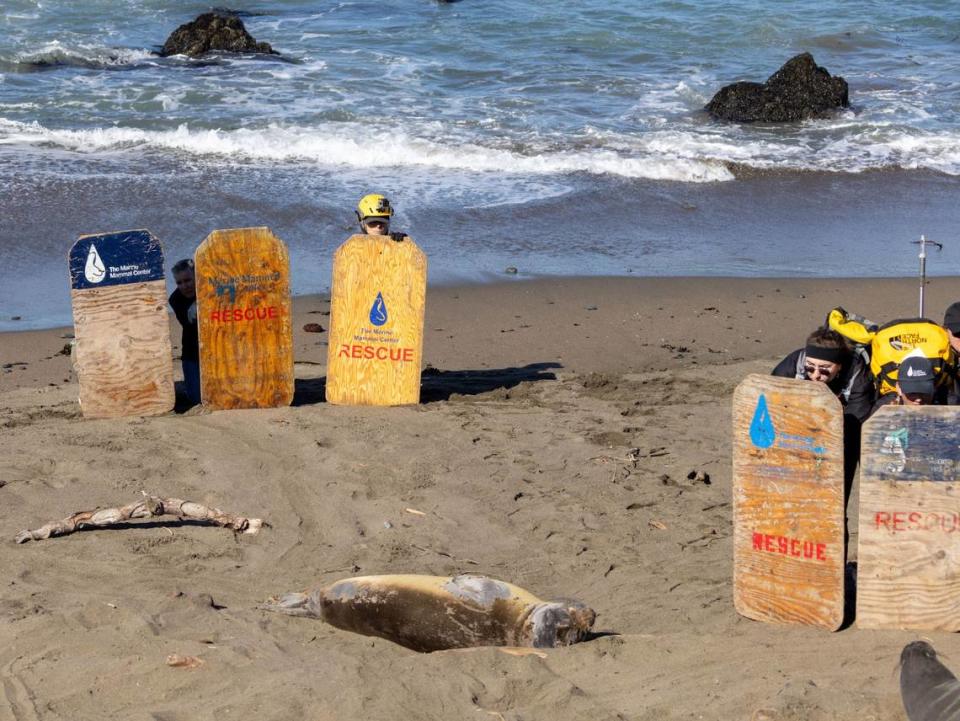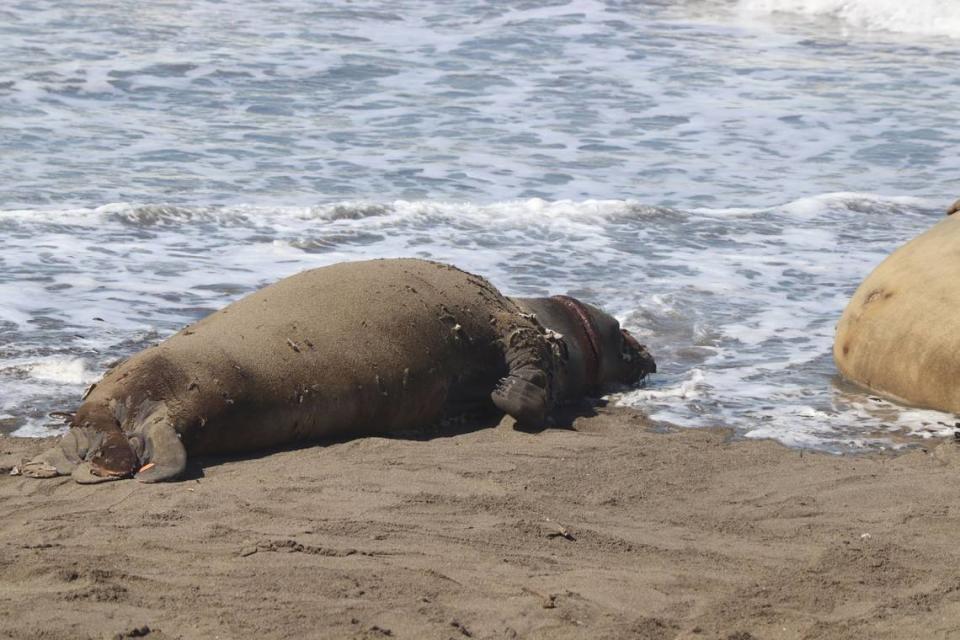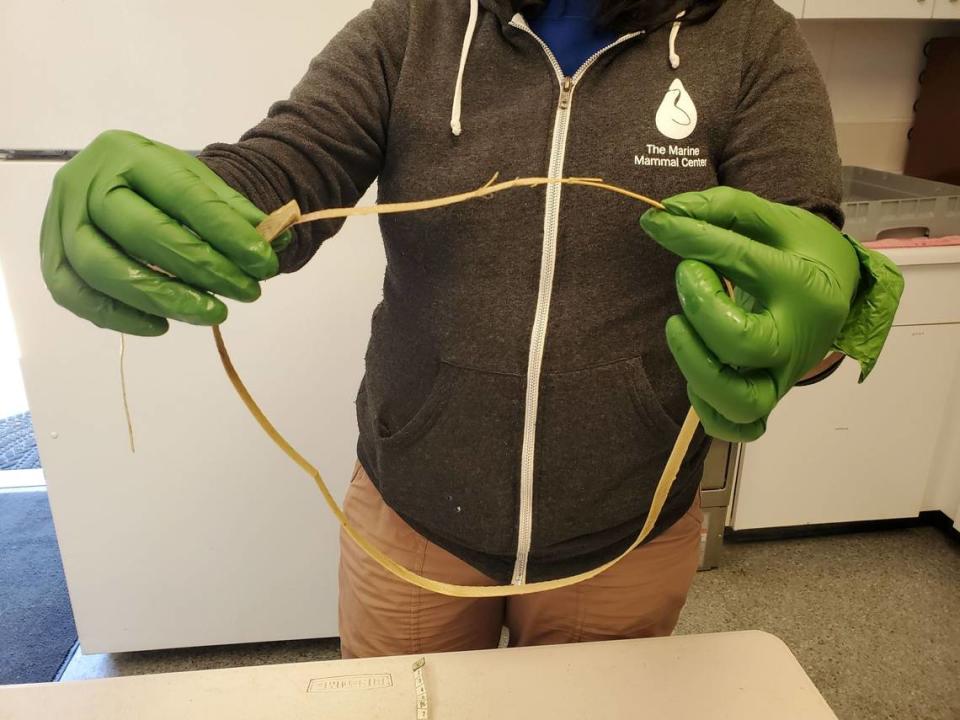Elephant seal with plastic around neck was slowly starving. Then SLO County rescuers stepped in
The morning was clear and calm, with a light breeze that whispered across Piedras Blancas as hundreds of elephant seals slept or shifted against each other on the beach.
Quietly, a team from The Marine Mammal Center climbed down onto the sand to help one seal in particular: a young female with a plastic strap cinched so tightly around her head it was cutting deep wounds into her blubber.
The strap had clearly impacted her ability to forage. She was thin — even bony — and in generally poor condition.
Friends of the Elephant Seal docents had been observing the seal for more than a week.
They took photos and reported her location to the Center. They recognized her from last fall, when she was photographed in October with that same strap around her head. A team tried to reach her then, but she escaped back to the ocean when she saw them coming.
It’s not always easy to help a wild animal.
Now, months later, the plastic had cut deeper into her blubber. She’d lost weight, and her condition was more dire. If the strap stayed on, it was clear she’d continue to suffer until she died.
So Aliah Meza, operations manager of The Marine Mammal Center’s Morro Bay facility, began making a plan to rescue her.
“We had a second chance,” Meza said.
And they wouldn’t squander it.
Group strategizes how best to help entangled elephant seal
Coming up with a plan to rescue a wild animal is a lesson in anticipating what might go wrong.
“We wanted to plan for good scenarios, as well as if things didn’t go our way,” Meza said. “We aligned everything we could think of.”
The general plan was to sedate the seal, look at the entanglement, remove it, take care of the wound and then watch as she recovered to ensure everything had gone OK.
The day of, the team arrived at the viewpoint at 7:30 a.m., but strategized until 10 a.m. before going down to the beach.
“We can have a great laid-out plan, and then she moves, and we have to re-evaluate,” Meza said.
Additionally, going onto the beach to rescue an entangled seal requires special permission from National Oceanic and Atmospheric Administration, the federal agency with responsibility for wildlife in national marine sanctuaries. Permission depends on a variety of factors, such as where the seals are in their annual life cycle.
In May, adult females and juveniles of both sexes are on the beach to molt, though no nursing pups who might be separated from their mothers are on the beach at that time.
No matter what, seals would have to be disturbed to clear a path to the entangled seal.
“The only reason we were allowed to do this is because it’s a human-caused entanglement,” Meza said.
The Marine Mammal Center team makes its move
On the day of, the six members of the team approached the seal from the ocean side. Two carried herding boards and shuffled the other seals away to isolate the entangled seal. The other four were directly involved in caring for the target seal.
Heather Harris, associate veterinarian for the Center’s operations in Morro Bay, was there to sedate the seal and treat her wounds.
“We used our boards to form a path to our target animal,” Harris said. “The other animals moved aside and settled nearby, so that was perfect.”
Seems elephant seals can sometimes cooperate.

Meanwhile, Harris had to estimate the seal’s weight to calculate the correct dose to sedate her. Dosage is based on weight, so she consulted with other Center staff members to make a guess as to what Necklace weighed.
Ultimately they found her weight was below the normal range.
On the Center’s scoring system for condition, Necklace was in the lowest classification. Lacking adequate blubber to fill out her neck gave her a “peanut head” of emaciation. Her spine and pelvic bones were prominent, and she had a steep angle from her shoulders to her pelvis.
“All those characteristics made us classify her as on the very thin end of the spectrum,” Harris said.
Once she got close enough, Harris used a long syringe on a pole to inject a drug to reduce pain and stress temporarily, long enough to remove the entanglement.
“She reacted very well,” Harris said. “It was very smooth. She became quiet enough that we could approach her.”
There would be no repeat of last year’s return to the ocean.
Next, they covered her eyes with a towel, to help keep her calm and monitored her heart rate and breathing while she was sedated. All her vital signs were stable.

Elephant seal not the first to have to be rescued from plastic tangle
At that point, Harris was able to find the offending entanglement and cut it off. It turned out to be a plastic packing strip.
Plastic trash is especially harmful to marine wildlife, because it is so strong and long-lasting. The plastic strap wrapped around Necklace, for example, would never have broken on its own.
She isn’t alone in her experience. Green Tie, a mature bull, had two around his neck, giving him unique scars that made him recognizable after the straps were removed. He went on to become a beachmaster at Piedras Blancas.
All plastic trash is dangerous to marine life, but the unique nature and rigidity of plastic packing straps make them especially hazardous to seals and sea lions.
Birds, turtles and other marine animals can also get entangled in plastic beverage can holders — often a death sentence.
Because of that, it’s recommended people cut all circular plastic such as packing straps and beverage can six-pack holders before throwing them away.
“As coastal stewards of our environment who live along the coast, it’s important for us to take responsibility for our trash,” Harris said. “This is trash that ended up in the marine environment. Taking responsibility for our trash, taking time to pick up trash when we see it, and not waiting for someone else to do that, participating in beach clean-ups, and joining rescue organizations like The Marine Mammal Center as a volunteer, really allows people to participate in this process and save individuals.”
What is healing process for rescued elephant seal?
With the strap out of the way, Harris examined the wounds to determine how deep they were and whether any vital structures were injured, such as her airway or any bones.
“We were very pleased to see that it was not impacting anything vital,” Harris said. “It was just through the blubber and into the muscle.”
Another stroke of luck: The wound wasn’t infected, so Harris didn’t have to give the antibiotic that she had a permit to administer.
“We’re very careful about giving antibiotics because of the development of antibiotic resistance in the environment,” she said. “We want to be very deliberate when we’re doing that. We didn’t see any indication for doing that on this animal.”
As the sedation wore off, Necklace woke up. In her elephant seal way, she flipped sand on herself and settled back onto the beach where she will be left to continue healing.
“They heal very well in salt water,” Harris said. “It’s the best natural treatment there is.”
Necklace will likely remain on the beach for a couple more weeks, completing the catastrophic molt that’s common for young seals. During that process, the skin peels off in chunks to expose new skin.
Scars stay forever, though.
Necklace’s unique scars will make her identifiable in the future. Harris also attached numbered orange tags to her flippers. Orange tags identify marine mammals that have been rehabilitated, to distinguish them from research animals, which get colored tags identifying their birthplace.
Scars can be so deep that it looks as if the seal is still entangled. The orange tags signal that the entanglement has been removed.
Meanwhile, the other adult females on the beach are pregnant. Although Necklace is mature enough to be pregnant, she probably isn’t, because of her emaciation and poor condition, Harris said.
“She probably couldn’t support a pregnancy, but we don’t know,” Dr. Harris said. “We’re very hopeful that she’ll be able to return to a productive life as a female elephant seal.”

Rescue ‘took a village,’ organizer says
Harris and other Center volunteers and staff will continue to monitor her, as will Cal Poly Team Ellie students under the supervision of Heather Liwanag.
“We’re just so happy that there’s Friends of the Elephant Seal docents up there who are keeping their eyes on all these animals, especially on her,” Harris said. “Lots of eyes out there looking for her.”
Visitors helped, too.
Karen Friedmann of San Jose visited the viewpoint the Thursday before the rescue. She has expertise in wildlife photography and took photos with her long lens camera that showed the right side of Necklace’s head, which helped Center staff plan the rescue.
“It really does take a village,” Meza said. “All that information helped us create a better plan and make us feel a lot more safe.”
Necklace may be difficult to identify among thousands of seals at Piedras Blancas, but the viewpoint is always open. Visitors can see her and the rest of the seals as they molt their skin in May. Friends of the Elephant Seals docents even have samples of shed skin for visitors to handle.
“The stars were aligned for us on this one,” Harris added. “We really celebrate those moments, because this is a human-caused injury. We take this especially seriously. We want to intervene when we can and use our expertise to help the situation and help the animal.”
Become a volunteer
The Marine Mammal Center and Friends of the Elephant Seal are always looking for volunteers. Find out how to participate at marinemammalcenter.org and elephantseal.org.
“People can make a difference with their own lives, their own habits, but also joining a group like this, they can be on the front lines and feel like they are making a difference,” Harris said.
Volunteers can serve in many capacities.
Teams are on call to rescue stranded mammals, as well as providing support services. Friends of the Elephant Seal docents have regular training programs so they can educate the public, as well as positions serving in the San Simeon Visitor Center.

